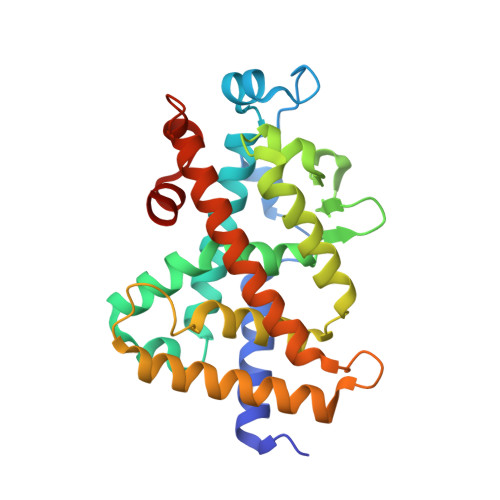HDX reveals the conformational dynamics of DNA sequence specific VDR co-activator interactions.
Zheng, J., Chang, M.R., Stites, R.E., Wang, Y., Bruning, J.B., Pascal, B.D., Novick, S.J., Garcia-Ordonez, R.D., Stayrook, K.R., Chalmers, M.J., Dodge, J.A., Griffin, P.R.(2017) Nat Commun 8: 923-923
- PubMed: 29030554
- DOI: https://doi.org/10.1038/s41467-017-00978-7
- Primary Citation of Related Structures:
5V39 - PubMed Abstract:
The vitamin D receptor/retinoid X receptor-α heterodimer (VDRRXRα) regulates bone mineralization via transcriptional control of osteocalcin (BGLAP) gene and is the receptor for 1α,25-dihydroxyvitamin D 3 (1,25D3). However, supra-physiological levels of 1,25D3 activates the calcium-regulating gene TRPV6 leading to hypercalcemia. An approach to attenuate this adverse effect is to develop selective VDR modulators (VDRMs) that differentially activate BGLAP but not TRPV6. Here we present structural insight for the action of a VDRM compared with agonists by employing hydrogen/deuterium exchange. Agonist binding directs crosstalk between co-receptors upon DNA binding, stabilizing the activation function 2 (AF2) surfaces of both receptors driving steroid receptor co-activator-1 (SRC1) interaction. In contrast, AF2 of VDR within VDRM:BGLAP bound heterodimer is more vulnerable for large stabilization upon SRC1 interaction compared with VDRM:TRPV6 bound heterodimer. These results reveal that the combination of ligand structure and DNA sequence tailor the transcriptional activity of VDR toward specific target genes.The vitamin D receptor/retinoid X receptor-α heterodimer (VDRRXRα) regulates bone mineralization. Here the authors employ hydrogen/deuterium exchange (HDX) mass spectrometry to study the conformational dynamics of VDRRXRα and give mechanistic insights into how VDRRXRα controls the transcriptional activity of specific genes.
Organizational Affiliation:
Department of Molecular Medicine, The Scripps Research Institute, Jupiter, FL, 33458, USA.















